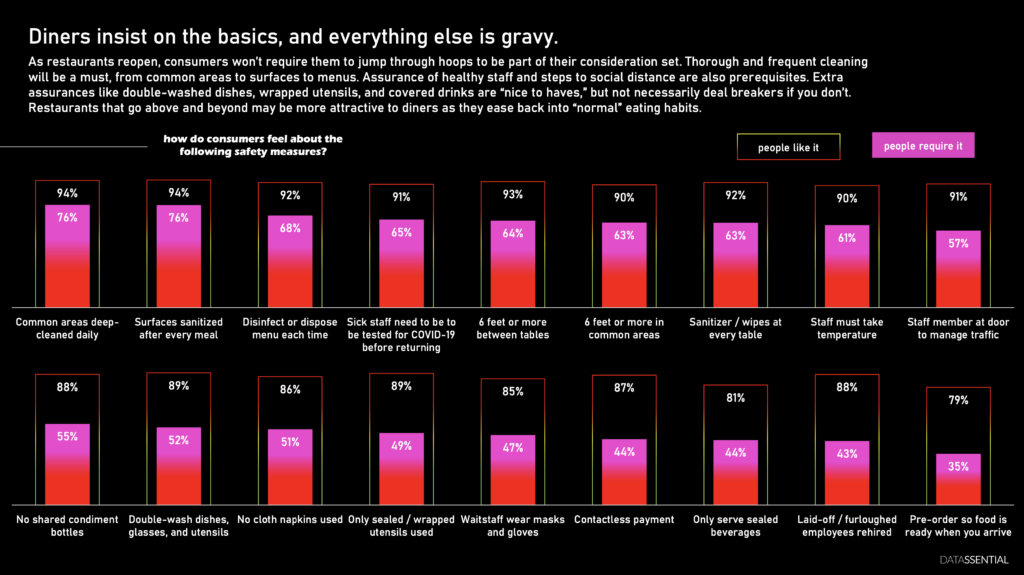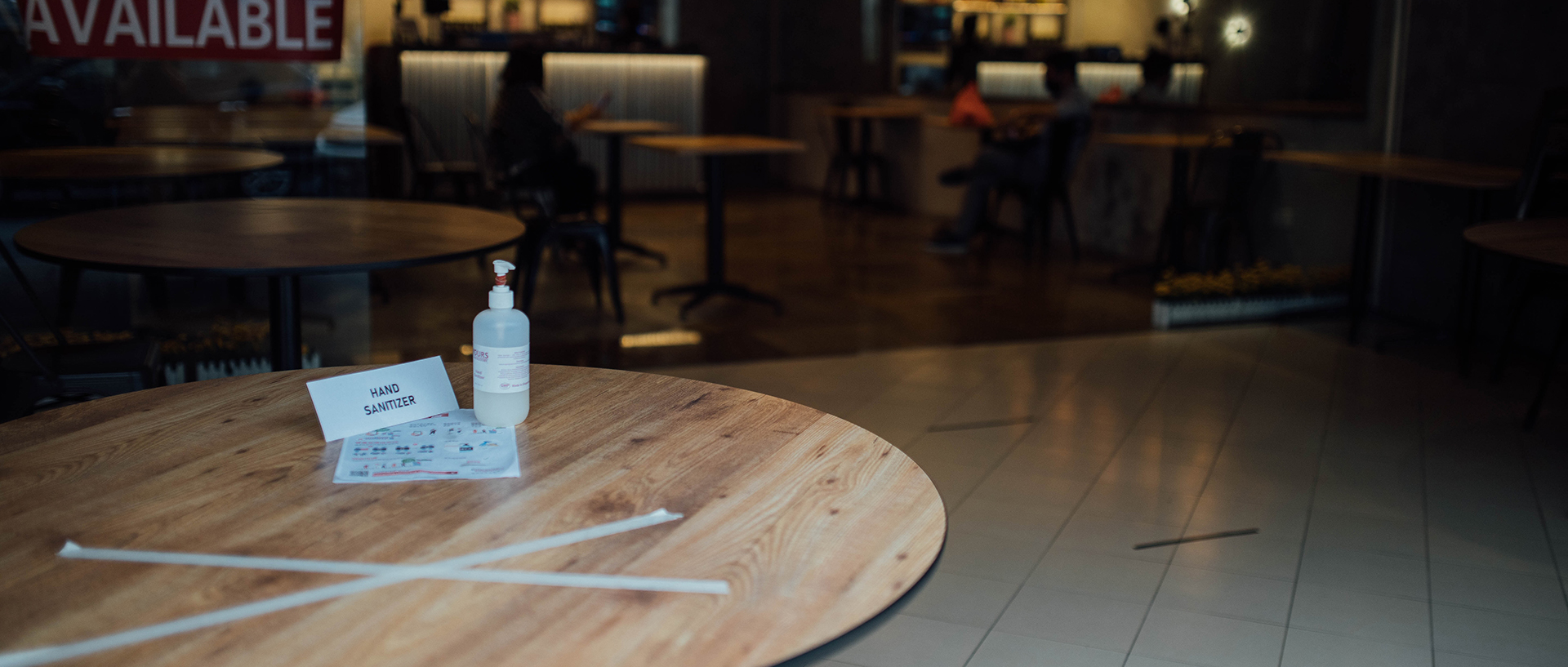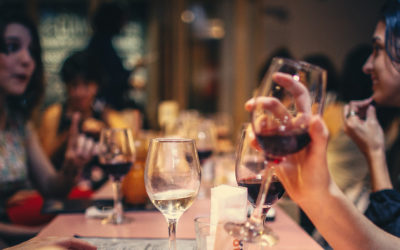As consumer confidence wavers, people look to restaurants as a beacon in the return to normalcy. Think back to all those birthdays, anniversaries, or a fun night out. The moments that matter often take place in restaurant dining rooms, pubs, hotel bars, or cafes.
With dining-rooms reopening, the question remains: what restaurant sanitation procedures are patrons expecting, and how does that affect your guest and brand experience?
Restaurant diners are rightfully apprehensive
Before COVID, we all had our go-to favorites, whether it was that classic mom n’ pop diner, the steakhouse where you celebrated an anniversary, or a late-night snacking spot. Then, economies came to a grinding halt, consumers increasingly soaked up information on proper sanitization, and restaurants started closing dining rooms. Even as quarantine restrictions begin abating, newfound knowledge about proper sanitary conditions does not. Instead, they drive influential changes in behavior.
Given this reality, it’s unsurprising that restaurant diners are apprehensive.
In a study of 1000 respondents performed by Datassentials, only 34% felt comfortable enough to go back to restaurant dining rooms. Even relatively open spaces such as parks are considered appropriate to only half of the respondents. Everyone is reasonably cautious, despite easing restrictions and guidelines. The sentiment amongst consumers varies depending on the type of operation and demographics they fall in. 57% of respondents consider buffet-style restaurants too risky compared to 34% in a table service restaurant. Some restaurant models undoubtedly have a larger hill to climb, and while challenging, there are signs consumers associate restaurants with a return to normal life.
Why are restaurants associated with normalcy?
It’s been a time with increased introspection and many are feeling the effects of that on a personal level. 43% of respondents in Dataessential’s study they’re more grateful for things they typically took for granted.
Restaurants everywhere have always been a place of joy, relaxation, and comfort. To operators in the industry, a restaurant is its operations, workflows, technology, and how that blends into a great guest experience. To consumers, they signal a return to pre-COVID life.
71% of respondents agree that eating at a restaurant will make them feel normal again. Consumers are apprehensive, but they’re looking to restaurants to lead the return to normalcy. The next question is: what exactly are diners expecting?
What are diners’ must-have restaurant cleaning procedures?
The short version is diners want increased sanitization and social distancing space but are reasonable in what they expect. Breaking down stats from Datassentials, most consumers are looking for:

credit: Datassentials
These are fairly standard requirements, with restaurants of all service types adhering to each to some degree already. Consumers aren’t asking for hospital-level sanitization, they simply need to feel safe in dining rooms. That alone is good news. For instance, 88% of diners may like the idea of using wrapped utensils, but only 49% require it. However, the balance needs to be weighed on multiple levels, including your guest preferences. Only 47% require waitstaff to wear masks and gloves, but prevailing conversations recommend them.
Would wearing a mask be a good idea? Probably, as it would make diners feel safe.
The balancing act between your operation, making diners feel safe, and the guest experience is the tightrope the industry is now walking on.
What does my restaurant model look like now?
Most guidelines limit restaurant capacity to 50% occupancy. The ability of your restaurant to maximize that limit is reliant on how well your operation walks the tightrope. For some restaurants, that could look very different today compared to pre-COVID.
Speed and Convenience with Quick Service Restaurants
A quick-service restaurant like a pizza shop is well positioned to adjust. If you own a quick-service restaurant, you know your customers are typically in-and-out quickly. Moreover, they’re comfortable using virtual kiosks, ordering apps, or calling ahead.
The experience is typically centered around convenience and speed. You may reconsider the flow of lineups, driver-pick ups, and consider contactless payment options like Readypay. If it took your guest 5 minutes to order and receive a pizza slice, your goal is to be as close as possible to that.
You also want to signal to consumers that restaurant sanitation is priority #1 at this time. Use the time diners spend in your dining area as an opportunity to signal what you’re doing to keep them safe. Signage detailing sanitization measures taken, masks, and visible distancing procedures would likely top your list.
Traditional Table Service Restaurants
In a traditional table service restaurant environment, the personal and human interaction with the server is still core to the guest experience.
However, guests remain open to opportunities that reduce physical interactions or shared surface exposures. Consider plastic-covered menus, for example; how can you push these digitally to guests? Or in a contactless manner with signage? Guests may be comfortable with options for self-ordering, online ordering apps, and contactless payment. Adding tips on a payment terminal typically requires physical interaction, but a solution like ReadyPay allows guests to tip via their phone. Providing diners with those options to reduce server interactions could be a reasonable compromise.
On the other hand, if server interaction is key to the guest experience. Make sure every server has their own tablet for ordering, and the payment interaction is contactless. Similar to quick-service models, use the time guests are in dining rooms as an opportunity to highlight your protocols. Signage, masks, and even staff managing spaces in waiting or pick up areas.
Maintaining premium experiences with Fine Dining Restaurants
Attentive premium service and a focus on food quality is core to the experience in fine dining.
The typical workflow of a coursed meal, frequent plate swaps, and even tableside food preparation requires a different approach. Guests are aware certain concessions need to be made. They may want to pour their wine and are OK with tableside prepared dishes being cooked in the kitchen now. This may lead to tweaked menus or reduced server interactions.
Consider guest perceptions of your brand too. Personal Protective Equipment (PPE) can come in many colors and styles. Does a mask in hospital blue make sense if your brand experience emphasizes warmth and comfort? The key is maintaining a premium experience. The definition of premium is just different than before.
Regardless of your service model, ensuring staff has an appropriate amount of PPE is key to their safety and that of your guests. Staff need to feel just as safe working, as guests do dining. Ensuring proper protocol training and documentation will be essential in operationalizing PPE usage.
Unfortunately, some models would need a more significant overhaul. A buffet with shared food stations is the exact opposite of what guests are comfortable with. In a situation like this, it’s necessary to pivot and adjust the model. Whatever the service style, there is now an abundance of technology to help. Putting the pieces together can set your brand apart.
Why this might be an opportunity for your brand to differentiate
From a guest safety perspective, finding the best workflow to follow new restaurant sanitation procedures can yield huge benefits. The restaurants that can operationalize new formulas for increased table cleaning, shared space sanitization, and social distancing measures will stand out.
If restaurant A can get an order in and seat diners within a clean environment in the same time frame it takes a restaurant B to wipe tables down, there’s a clear advantage there.
Now imagine that restaurant B seats guests too close together. Guests are paying close attention to these measures as they ease themselves back to dining rooms. Prior operational benchmarks no longer apply, and those who set new ones will succeed most.
There’s a wealth of guides out there, but you can expand the thought process beyond checking items off your restaurant kitchen cleaning list. By combining new protocols with the right technology, your operation can yield increased service times, smooth staff scheduling, and a labor force eager to provide guests a great experience. Pre-COVID, most servers shared a POS system on the floor. With modern tablet options, your staff can minimize shared surface interactions while enabling the benefits of mobile pos systems, like increased ordering speeds.
A virtual kiosk option like ReadyPay can even eliminate close-contact server interactions.
When it comes to food safety, diners trust restaurants to follow sanitation protocols. How that’s accomplished has been standard in BOH operations for quite some time, and it’s about combining that with proper staff precautions. Through proper PPE usage and ensuring staff are not sick and symptomatic, most diners would be made comfortable with a restaurant’s food safety standard.
Consider your current menu – does it require adjustment or tweaks given the consumer temperature? Are there items that are difficult for staff to prepare with PPE, or items diners may question right now?
Ultimately, a combination of staff PPE, operationalizing new sanitization protocols and menu tweaks can uplift your brand amongst the competition.
Every restaurant is back to square one and diners are waiting
Consumers are reluctantly waiting for restaurants to make the next move. No one wants to feel like their favorite restaurant turned into a hospital. Few are certain what the best practices are. While there is a strong sense of confusion, it also provides an opportunity to set new standards. In a way, this has brought restaurants back to square one.
Those who succeed will be restaurants that can carefully balance guest safety with exceptional service, quality food, and a brand experience like no other. The difference now is guests want a return to normal; those who can come close first will succeed.



